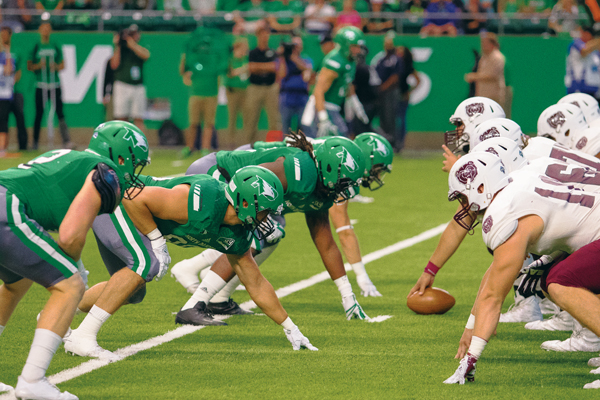Taking a redshirt year
What a redshirt is, and why it’s becoming more common

Fighting Hawks football players line up against Missouri State during this season’s Potato Bowl football game at the Alerus Center.
November 15, 2017
It’s becoming more and more common in the world of college sports to have athletes take a “redshirt” year. This means that the athlete can practice with the team and is required to continue going to school, but cannot compete under the name of the college or university during the season they decide to sit out.
Redshirting is most prevalent in sports where incoming freshman aren’t at the level they need to be to compete well against the competition or in sports where injuries are common. Taking a redshirt year allows for the athlete to compete for a fifth year with the team.
Some colleges want to make the most of their athletes and get the best four years they can. Teams with this goal will most likely encourage incoming freshman to redshirt. However, by doing this, the coaches are taking the risk that the athlete might get injured at some point during the following four years and end up wasting an entire season.
An example of a team that does this is the University of Minnesota cross country and track team. The coaches firmly recommend that every one of the incoming freshmen redshirt, and most do unless they have a strong opposition to the idea.
The University of Minnesota’s redshirt freshmen travel to different meets close to home and run unattached (wearing no school apparel) at the DIII level. One big drawback to competing unattached is that the athlete must provide their own travel.
By redshirting their freshmen, the University of Minnesota cross country and track team hopes to let the runners acclimate to the change in environment and training program before they are thrown into some of the top DI races in the nation.
This doesn’t necessarily mean that their freshmen aren’t worthy of wearing the Minnesota jersey. In fact, just last year, U of M freshman Megan Hasz ran a time that would have broken the school record in the 5K while competing unattached.
Comparatively, some coaches see more benefit to letting freshmen compete on the team just in case something were to happen in later years that would prevent an athlete from competing.
The University of North Dakota’s cross country coach, Richard Clay, agrees more with this philosophy, and so far this mentality has saved a lot of seasons for UND’s runners.
Just this year, three women on the cross country team redshirted the season just because of injuries.
Clay also provides the opportunity to come back after deciding to take a redshirt season. For example, freshman Lydia Kantonen came into the season with a muscle injury near her shin. She had been cross-training in the pool or on a bike for about four months when the athletic trainers cleared her to start running.
After training for three weeks with Coach Clay and the rest of the team, Kantonen ran unattached at the home meet and finished up as the third runner on the team, putting her well within the range of the varsity squad which consists of seven runners.
Kantonen was given the option to abandon the redshirt season by competing on the conference roster in Utah, which she decided to do.
There are a lot of advantages and disadvantages to taking a redshirt season and a lot of thought goes into choosing whether or not to take one. Redshirting is becoming increasingly popular throughout all of the sports on college campuses. The ticking clock of eligibility for college athletes is able to be extended just that much more and it’s up to the athletes to use it wisely.
Madison Overby is a staff writer for Dakota Student. She can be reached at madison.overby@und.edu

